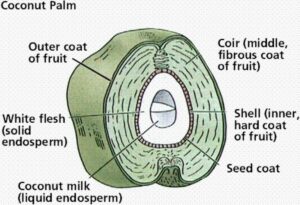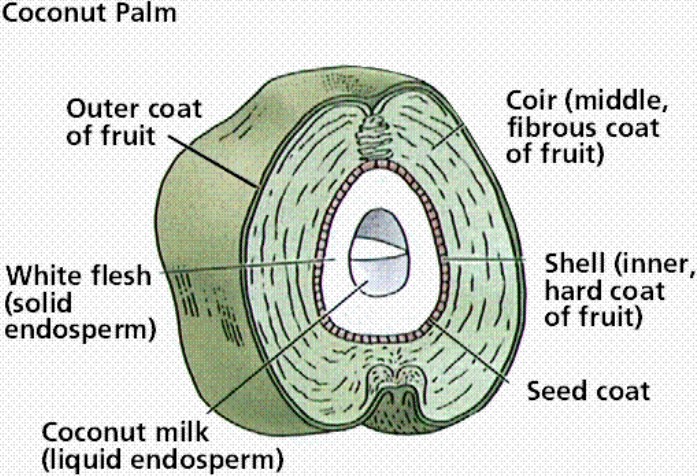Longitudinal section of a coconut fruit
A longitudinal section of a coconut fruit reveals its intricate and fascinating anatomy. The coconut, scientifically known as Cocos nucifera, is a versatile and widely consumed fruit with a unique structure that supports its various functions. This article will provide a detailed description of the longitudinal section of the coconut fruit, highlighting its different parts and their significance.
Longitudinal section of a coconut fruit

The outermost layer of the coconut is the exocarp, commonly known as the husk. The exocarp is a thick, fibrous layer that serves as a protective covering for the fruit. It consists of rugged, brown-coloured fibres that surround the entire coconut. The husk protects against physical damage and provides insulation to the inner layers.
Beneath the exocarp lies the mesocarp, the middle layer of the coconut. The mesocarp is the edible portion of the coconut and is commonly referred to as the “meat” or “flesh.” It is made of a white, creamy substance rich in oils, proteins, and carbohydrates. The mesocarp is the part of the coconut commonly used in cooking, baking, and as a source of nutrition.
The mesocarp has three distinct layers: the epicarp, the endocarp, and the basal endosperm. The thin, transparent layer of the epicarp directly surrounds the coconut water. It acts as a protective barrier against microbial contamination and maintains the freshness and purity of the water.
Beneath the epicarp is the endocarp, a complex, woody layer that encapsulates the coconut water and the developing seed. The endocarp is brown and is commonly referred to as the “shell” of the coconut. It provides structural support and protects the internal contents of the fruit from external forces.
The basal endosperm is located at the base of the coconut and serves as a reservoir of nutrients for the developing embryo. It is a thick, gelatinous layer that stores essential carbohydrates, proteins, and lipids required for the growth and development of the coconut seed. The basal endosperm is rich in nutrients and is a nutrient source for germination. At the centre of the coconut fruit lies the endosperm, which is the primary storage tissue of the coconut seed. The endosperm is a white, solid mass that surrounds the coconut water.
It comprises proteins, oils, and carbohydrates, nourishing the developing embryo. The endosperm is also responsible for coconut meat’s rich, creamy texture and distinct flavour.
Within the endosperm is a central cavity known as the “coconut water” or “coconut milk.” Coconut water is a clear, refreshing liquid that is naturally sterile and contains numerous beneficial nutrients, including vitamins, minerals, and electrolytes. It serves as a natural source of hydration and is often consumed directly or used in beverages and culinary preparations.
The embryo, or the germinating part of the coconut seed, is located at one end of the fruit. It is a small, white structure that consists of a radicle, plumule, and cotyledon. The radicle develops into the root system, while the plumule forms the shoot. The cotyledon is the initial food source for the growing seedling until it can establish its means of nutrition.
In conclusion, a longitudinal section of a coconut fruit reveals its complex and well-adapted structure. From the protective husk to the nutrient-rich endosperm and refreshing coconut water, each part plays a vital role in the survival and propagation of the coconut tree. The coconut fruit is a remarkable example of nature’s ingenuity and has been widely utilized by humans for its nutritional value and versatile applications.
Also Read: Biology Specimen for WAEC 2023 and Answer
